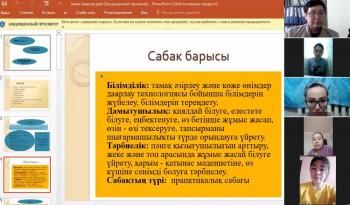Open lesson on "Cooking Technology"
- 651 views
Open lesson on "Cooking Technology"
Topic: Technology of making transparent soup
Educational program: 5B012000 - "Vocational training"
Group: Co-17
Course: 4
Teacher: senior teacher Saparbayeva U.A.
Video: https://youtu.be/YKv5xkIYW6s
The purpose of the lesson:
Accumulation and systematization of educational knowledge to explain the need to be a master of each business by proving that each profession has a place and importance.
Visualization of the lesson: textbook, electronic textbook, slides.
Methods: Brainstorming, question-answer, explanation, feedback.
Type of lesson: practice
Visual aids used in the lesson:
1. Tasks
2. control issues
3. Literature
Education: systematization of knowledge on the technology of cooking and soup production, deepening of knowledge.
Development: to learn to imagine, to imagine, to work, to work independently, to check themselves, to perform tasks creatively.
Educational: to increase interest in the subject, to teach to work individually and in groups, to cultivate a culture of communication, self-confidence.
Lesson progress:
Organizational period is 5 minutes
Briefly review the previous lessons, collect ideas from the students of the group, introduce the topic of a new lesson.
New lesson 25 minutes
Task: To provide students with a written presentation on the technology of cooking on the content of a new topic
Brief theoretical information:
I. Organizational stage: Studying the readiness of students for lessons.
II. Homework check: Check homework on the list.
III. Explain the new lesson
"Technology of making transparent soup"
Soup plays a very important role in human nutrition: it stimulates the appetite, satisfies a significant part of the body's need for water, and is also a source of vitamins, minerals and other biologically active substances. Soups consist of a liquid base and various foods.
Liquid-based extracts of soups and fermented cabbage, tomatoes, pickles, etc. Organic acids, the taste and aroma of food for cooking soups open the appetite.
The foods in the garnish (vegetables, cereals, meat, fish, etc.) are very rich in carbohydrates, fats and proteins. Soups are divided into hot and cold. Hot soups (75-80 C) with broth (bones, meat, fish and poultry), milk and decoction (mushrooms, cereals, vegetables), and cold soups (7-14 C) with kvass, yogurt, kefir, beetroot juice and The kvass is prepared with beet cooking water.
Along with the menu, we need to know 10 rules of food culture, which are:
1. Everyone should get enough energy from food for 1 day.
2. It is better for everyone to eat 4 or 5 times a day.
3. Meals should be taken at the same time every day.
4. The temperature of hot food should not be less than 50 - 60С, cold food - not less than 10С.
5. The last meal should be 2 hours before bedtime.
6. It is necessary to change the type (diet) of food
7. Boiled, steamed, steamed food is useful.
8. Food should be chewed slowly
9. Eat lots of liquid foods, vegetables and fruits
10. Milk, sour foods made from milk should be eaten
Control questions:
1. What is nutrition?
2. Rules of nutrition
3. Food culture
4. Technology of making noodle soup

